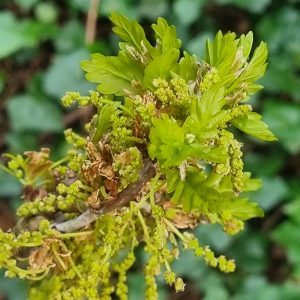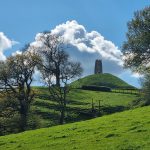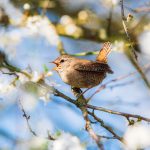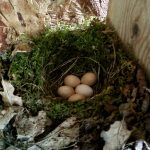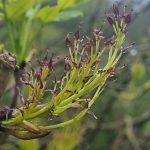As I unpick the introduction to this month’s article, I stand at the moment of oak’s bud burst, a significant turning point that for me marks the true arrival of Spring and safely confirms the imminent arrival of consistently fine weather, if such a thing can exist.
The bright gold green explosions sprung from the cracked oak buds resemble the trailing ribbons of a million unravelled party poppers, with parts spilling, dangling and protruding all over the place. Oak flowers appear as a spray of reproductive parts amongst a bed of tiny oak leaves. The more subtle female flowers, barely visible, appear atop the displays, while the more blatant male flowers dangle beneath, spraying pollen willy-nilly upon Spring’s breeze.
At this stage of the season, the oaks’ leaves appear in their most darling forms , they are tiny and translucent, clumsy and dainty little fingers and thumbs that will remain as miniature impressions of oak leaves until all the business of Spring’s orgy on the breeze has subsided and they are allowed to develop into the thick, leathery, mismatched and wonky leaves, of which we are most familiar – each lobed leaf a unique form that describes the way in which it came to be.
The ash trees have now flung open the gates of their diamond black buds to extend their reproductive organs. Ash has the most unfussy of flowers – no catkins or petals to speak of – only bare. stalks, pistils and stamens, with very subtle anthers and stigma on the male, female. and hermaphrodite flowers. They are mantis-like, or else seem to be most closely related to a creature of the deep ocean that has no need to appear pretty, but somehow in the commitment to its functionality, embodies its own unique beauty.
We will be waiting for the end of this month’s newsletter before we see the full unfolding of the mature ash trees’ fine pinnate leaves, though we can observe some of the busy little saplings and hedgerow specimens making the most of the early sunshine before their parents steal the light.
The ash emergence this year, are far later than the oaks, which would suggest, as the folklore recites, that we are in for a splash rather than a soak. In some circumstances the lack of ash flowers and leaves might also be down to dieback.
Ash FlowersWhile the Holy thorns are coming to the end of their second flowering, the native thorns pick up the baton, the mayflower, aptly named for its almost religious devotion to the display of flowers in the month, can be seen carefully extending the stems upon which will bloom sprays of their dear five petalled flowers, in their perfect hermaphrodite form. In some cases the renegade hedgerow hawthorns and those close to lanes, where it’s slightly warmer, have already started to blossom.
Elder has been long at its leafing, its foliage is some of the first to be noticed at the end of Winter and is now well established in the scenery. The elders now begin to extend the parasol structures upon which will appear displays of their tiny white flora. To release its flowers, the elder would like to see a consistent increase in the heat that brings more numerous pollinating insects who do the job of transforming the pretty white flower domes into deep purple elder berries.
So abundant are the changes at this time of the year that given the time to observe and to write, I could produce a newsletter every day. As we approach the middle of this ramble through Spring’s approach, I stand in the orchards, where the plums, past blossoming, are now in full leaf, and the apples begin to fill their bare canopies with the first signs of pink and white blossom amongst sprouts of green foliage.
The surrounding hedgerows, now twitching with avian activity, start to stretch their new growth and provide the perfect platforms from which their tiny residents can belt out their full spring chorus. The wrens are most notable at present, they are numerous in the hedge, and gather to lay claim to their nook in the row, firing off repeated rounds of their quick rolling song which appears almost mechanically, as if cranked from its gaping bill – A song seemingly far too big for its maker, yet, recited word-for-word over and over, with very little time for breath.
On a recent walk, I believe I witnessed the Master of all wrens! Its song was intense and incessant, with numerous nuanced developments that gave the impression that this wren was a highly experienced vocalist. Other less experienced wrens were busy shouting back in half formed rounds, more tentatively, before their teacher interrupted again, correcting its students, and instructing them in the intricacies of their song. I understand their gaping shouts to translate as something like:
“I am the loudest and strongest,
My nook is the cosiest in the land,
My freshly woven nest is the finest,
And my spot the most abundant.
Hear my song!”
The return of the blanket of bird song felt a long time coming, hindered by unsettled weather. I have enjoyed the blackbird’s chorus in the bay tree outside my bedroom window, coaxing me from my sleep and I have already enjoyed a handful of evenings listening to the birds sing the sun down, which is where I am as I write this. Excitedly, I also spotted my first swallow on the 16th April.
 The end of this newsletter is completed in the pastures where the green tide begins to rise. The grasses, cow parsley, and nettles start to poke their heads out, gaining inches by the day, and the buttercups, clover, and dandelions become more numbersome.
The end of this newsletter is completed in the pastures where the green tide begins to rise. The grasses, cow parsley, and nettles start to poke their heads out, gaining inches by the day, and the buttercups, clover, and dandelions become more numbersome.
They reveal once again, the meandering maps of badger, fox, and deer, stretching from row to row, disappearing beside gateways or through darkened holes now arched by fresh Spring greenery. Invisible in the winter it’s only by the rising fields that the trodden routes are written into the landscape, and are picked out further by the shadows cast by the low setting sun.
I feel welcomed and comfortable as deer graze the hedges, this one in particular is not much fussed by my presence and might even recognise me from last year as I claim my spot to sing my own Spring songs to the land.
As I do so, it appears as if Spring sings back in full high res colour – The subtle hues, hints, spots, dots, spatters and blotches, patches and sprays of early Springs swatches, are now joined by bursts of new colour, as if Spring has widened its colour palette, grabbed all its brushes and is wielding them wildly in a frenzy of expression, quickly and thickly colouring in Spring’s horizon with the golds, whites, reds, pinks, creams, and all the various greens of this year’s foliage, arriving to take their seats up in the rafters, to watch and to take part in the show.
Upon Winter’s stretched canvas, framed by earth and sky, the new season paints itself into view – and very welcomed it is too.
MW – 23/4/24
Upcoming Tree walks
Public Tree Walks
Public tree walks will run twice a month through to November 2024. Dates for all upcoming walks can be found on the homepage.
Summer Tree Tour – Wedmore, Shepton, Wells, Glastonbury – A hadful of walks in beautiful Somerset locations. Event info.
Abbey Tree Walks
Next walk: Sat 4th May – Tickets from the Abbey website
Private walks
I host private walks for groups, couples and individuals. Contact Matt to arrange your walk. Read more about private walks.
Visual Diary
- Tor View – Lynches
- Wren singing
- Oak bud bust
- Oaks Bud Burst
- Early Oak Burst
- Eearly Beech Burst
- Early Hawthoirn
- Bluebell
- Robin’s nest
- Hornbeam Leaves
- Oaks Bud Burst
- The Way – Badger path
- Willow path
- Deer path
- Oaks Bud Burst
- Ash flowers
- The Way – Badger Path



